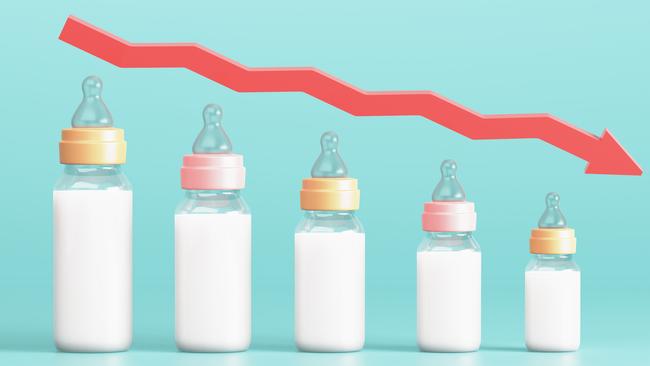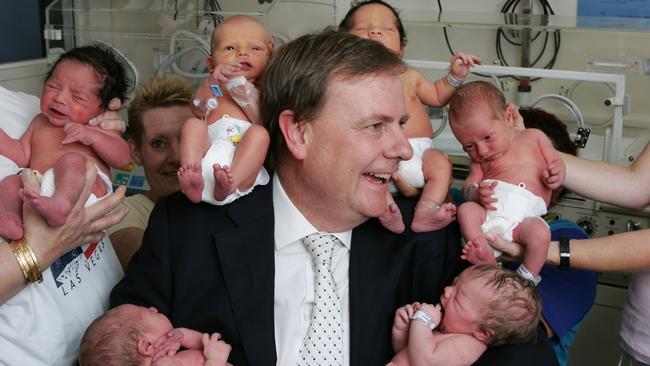
The reasons for Australia’s declining birthrate are difficult to explain in a tabloid headline, but the Sydney Morning Herald gave it a go last Wednesday.
“House prices blamed for Australia’s lowest birthrate on record,” read the front-page banner. Australian National University demographer Liz Allen told the newspaper: “Housing affordability, economic insecurity, gender inequality and climate boiling – that’s a recipe for the most effective contraceptive ever.”
If only life were so simple. The birthrate has been falling since 1959 when the average house in Sydney was less than $10,000 – $182,000 in today’s money. If there was an inverse relationship between house prices and births, the Poles would have more babies than we do since Poland has some of the most affordable housing in the OECD. The birthrate in Poland is 1.5, the same as in Australia.
Economic insecurity and gender inequality are equally improbable explanations. Australia is the tenth-most prosperous country in the world, as measured by GDP per capita. Yet the highest birthrates in the world are in sub-Saharan Africa, where people are among the world’s poorest. Chad, Mali and the Democratic Republic of Congo sit at the bottom of the World Economic Forum’s Global Gender Gap Index but rank among the 10 most fertile populations in the world.
Allen may be on to something with climate change, however. Performative childlessness has been popular in catastrophist circles for some time. The Birthstrike Movement’s website sets the misanthropic tone: “You can protect children while fighting climate change and systematic corruption by refusing to procreate!”

Yet population deflation is no longer just a First World problem. Birthrates have been falling almost everywhere since the 1960s. Birthrates have fallen below the World Bank’s nominal replacement rate of 2.3 in almost every Asian country, including India (2) and China (1.3). Thailand’s birthrate in 1960 was 6.1. By 2022, it dropped to 1.3.
The global birthrate has been hovering around the replacement rate since 2019, justifying the title of British demographer Paul Morland’s recent book, No One Left: Why the World Needs More Children. Moreland avoids the common trap of offering a simple explanation for complex phenomena. The link between rising prosperity and declining birthrates is at best a rule of thumb. It fails to explain for example why the fertility rate in Kenya (3.3 in 2022) has fallen much faster than in Nigeria (5.2) despite Nigeria’s more robust GDP per capita growth.
Education plays a part. In Western countries, however, the gap between the fertility rates of non-tertiary and tertiary-educated women is closing, and recent evidence shows that highly educated women are more likely to have children than those who merely have a bachelor degree.
Moreland concludes: “Whenever you think you have nailed some fundamental cause, an exception will present itself.”
One of the immediate consequences of falling birthrates is a worldwide labour shortage. In Russia, where the population has been in slow decline since the start of the century, the shortage of workers is one of the factors hindering operations in Ukraine. The UK Daily Telegraph summed it up in a black headline last year: “Russia running out of single-use soldiers”. The fiscal implications of the rising dependency ratio – the size of the working-age population compared to the number of retirees – were outlined in Treasury’s inaugural Intergenerational Report commissioned by Peter Costello in 2002. Yet governments are spending more, not less.
Immigration has delayed population decline in Australia as in much of the developed world. Yet it is doubtful if immigration can be sustained at the current inflated rate without damaging the social fabric, and we must expect the pool of potential skilled migrants to shrink as opportunities grow for doctors, IT experts and engineers in their countries of birth.

The trend isn’t likely to turn anytime soon. “Quite the contrary,” writes Morland. “There are many reasons to think that the fertility rate of the cohort now coming to potential parenthood, Generation Z, will be lower still than that of those who preceded them.”
He notes a distinct change in attitude among increasing numbers of young adults who, in addition to delaying having children, seem not to want them at all. This points to a generational change, “which almost guarantees that fertility rates will fall further in the coming decades”.
Moreland’s book is a comprehensive refutation of Paul Ehrlich’s 1968 bestseller, The Population Bomb, one of the foundational texts of modern environmentalism. Catastrophists may never accept the premise that the greatest threat to human existence is not too many people but too few.
Moreland offers a dystopian glimpse of the future in his account of the Korean Republic, which in 2022 recorded a birthrate of 0.8, the lowest in the world. This means each generation will be approximately 40 per cent the size of the one it succeeds. If the trend continues, the population of Korea will fall by 90 per cent over three generations.
Korea is far from the only country in the demographic death zone. Nations as diverse as Puerto Rico (0.9), Singapore (1.0), Spain, China, and Italy (1.2) are not far behind.
Our best hope is to persuade the environmentally anxious millennials and Generation Z to stop fretting about stranded polar bears and get busy making babies. If present trends continue, the next great extinction may be our own.
Nick Cater is a senior fellow at the Menzies Research Centre. A longer version of this article will appear in the November edition of Quadrant.







